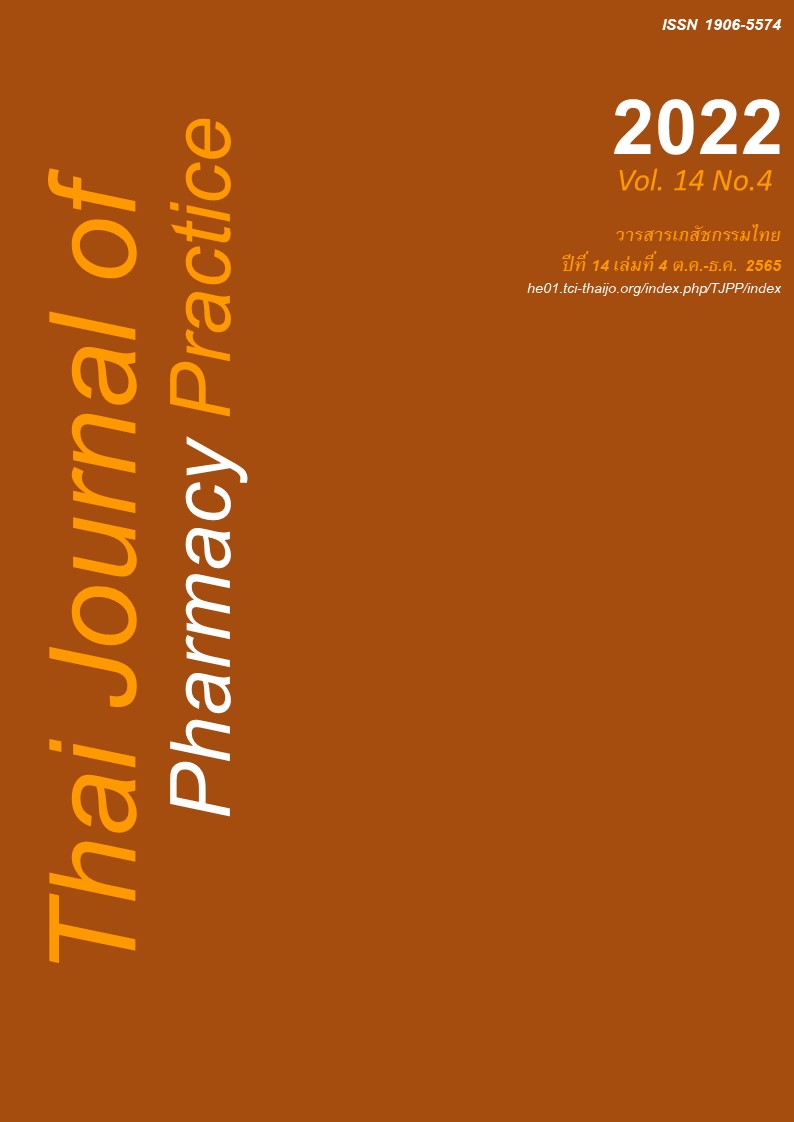ผลของโปรแกรมกลุ่มเพื่อนช่วยเพื่อนในการยกระดับสถานที่ผลิตน้ำบริโภคในภาชนะ บรรจุปิดสนิทตามหลักเกณฑ์วิธีการที่ดีในการผลิต: กรณีศึกษาจังหวัดอำนาจเจริญ
Main Article Content
บทคัดย่อ
วัตถุประสงค์: เพื่อจัดการปัญหาสถานที่ผลิตน้ำบริโภคในภาชนะบรรจุปิดสนิท (น้ำบริโภคฯ) ที่ไม่มีมาตรฐานในพื้นที่จังหวัดอำนาจเจริญ ด้วยโปรแกรมเพื่อนช่วยเพื่อน และเพื่อศึกษาความรู้ ทัศนคติ และพฤติกรรมของผู้ประกอบการต่อการเป็นสถานที่ผลิตน้ำบริโภคฯ ที่มีคุณภาพและมาตรฐานในพื้นที่จังหวัดอำนาจเจริญ วิธีการ: งานวิจัยแบ่งออกเป็น 2 ระยะ ระยะที่ 1 ตรวจประเมินสถานที่ผลิตน้ำบริโภคฯ ตามหลักเกณฑ์วิธีการที่ดีในการผลิตหรือเกณฑ์ ตส.3(50) และใช้แบบสอบถามประเมินความรู้ ทัศนคติ พฤติกรรมของผู้ประกอบการสถานที่ผลิตน้ำบริโภคฯ ต่อการเป็นสถานที่ผลิตน้ำบริโภคฯ ที่มีคุณภาพและมาตรฐาน ระยะที่ 2 เป็นการวิจัยกึ่งทดลอง โดยนำโปรแกรมกลุ่มเพื่อนช่วยเพื่อน มาประยุกต์ใช้ในการพัฒนารูปแบบการจัดการปัญหาสถานที่ผลิตน้ำบริโภคฯ ที่ไม่ผ่านเกณฑ์มาตรฐาน และวัดผลก่อนและหลังการใช้โปรแกรมฯ โดยใช้แบบประเมินจากระยะที่ 1 ผลการวิจัย: เมื่อทีมวิจัยตรวจประเมินสถานที่ผลิตภายหลังการเข้าร่วมโปรแกรมกลุ่มเพื่อนช่วยเพื่อน พบว่า สถานที่ผลิตน้ำบริโภคฯ ที่ตกมาตรฐานทุกแห่งผ่านเกณฑ์ โดยมีคะแนนดีขึ้น คือ คะแนนเฉลี่ยก่อนการเข้าร่วมโปรแกรม 56.8 คะแนน (จากคะแนนเต็ม 100) เป็น 76.8 คะแนนภายหลังการใช้โปรแกรม และมีความรู้พัฒนาขึ้น (20.02 ±3.61 จากคะแนนเต็ม 35) เป็น 26.02 ±2.60 ในช่วงหลังของการใช้โปรแกรม สรุป: การพัฒนาสถานประกอบการโดยใช้โปรแกรมกลุ่มเพื่อนช่วยเพื่อน ส่งผลให้เกิดการพัฒนาสถานที่ผลิตน้ำบริโภคฯ ที่ดีขึ้น และเกิดเป็นเครือข่ายผู้ประกอบการที่มีการดำเนินการอย่างต่อเนื่อง
Article Details

อนุญาตภายใต้เงื่อนไข Creative Commons Attribution-NonCommercial-NoDerivatives 4.0 International License.
ผลการวิจัยและความคิดเห็นที่ปรากฏในบทความถือเป็นความคิดเห็นและอยู่ในความรับผิดชอบของผู้นิพนธ์ มิใช่ความเห็นหรือความรับผิดชอบของกองบรรณาธิการ หรือคณะเภสัชศาสตร์ มหาวิทยาลัยสงขลานครินทร์ ทั้งนี้ไม่รวมความผิดพลาดอันเกิดจากการพิมพ์ บทความที่ได้รับการเผยแพร่โดยวารสารเภสัชกรรมไทยถือเป็นสิทธิ์ของวารสารฯ
เอกสารอ้างอิง
Food and Drug Administration. Statistics of food: food report [online]. 2015 [cited Feb 9, 2020]. Available from: www.fdd.gov.la/showContent_en.php?contI D= 15.
Food and Drug Administration. Country report on the food quality monitoring 2012-2017 [online]. 2018 [cited Jan 20, 2020]. Available from: www.fdd.gov.la /showContent_en.php?contID=21.
World Health Organization. Regional workshop of the International Network on Household Water Treat- ment and Safe Storage [online]. 2014 [cited Feb 9, 2020]. Available from: www.afro.who.int/ news/inter-regional-workshop-household-water-treatment-and-safe-storage.
Heisler M, Halasyamani L, Resnicow K, Neaton M, Shanahan J, Brown S, Piette JD. ‘‘I Am Not Alone’’: The feasibility and acceptability of Interactive Voice Response (IVR)-facilitated telephone peer support among older adults with heart failure (HF). Congest Heart Fail 2007: 13: 149–157.
Notification of the Ministry of Public Health on Drinking Water in Seal Container (Issue 61) B.E. 1981.
Notification of Ministry of Public Health on Drinking Water in Seal Container (Issue 135) B.E. 1991.
Notification of Ministry of Public Health on Drinking Water in Seal Container (Issue 220) B.E. 2001.
Notification of Ministry of Public Health on Drinking Water in Seal Container (Issue 256) B.E. 2002.
Notification of Ministry of Public Health on Drinking Water in Seal Container (Issue 284) B.E. 2004.
Notification of Ministry of Public Health on Drinking Water in Seal Container (Issue 6) B.E. 2010.
Food and Drug Administration. Statistics of food: food report [online].2017 [cited April 10, 2020]. Available from: newsser.fda.moph.go.th/food/index0 1php.
Chaweewan N, Chureeporn B, Boonsong Lee S, Sirinthip I, Karuna D, Pairin T. Production factors affecting the quality of drinking water in Sealed containers. Food and Drug Journal 1998; 5: 22-31.
World Health Organization. Regional workshop of the International Network on Household Water Treatment and Safe Storage [online]. 2014 [cited Feb 9, 2020]. Available from: www.afro.who.int/ news/inter-regional-workshop-household-water-treatment-and-safe-storage.
Ongsara N, Sungpud J, Liamtong S. Microbiological
quality of drinking water at Nakhon Si Thammarat Rajabhat University. Wichcha Journal Nakhon Si Thamarat Rajabhat University 2012; 2: 12-21.


